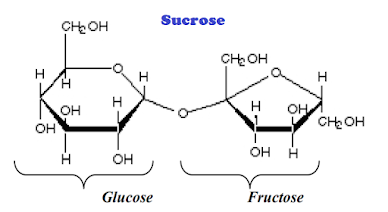Disaccharides
Disaccharides consist of two sugars joined by an O-glycosidic bond. The most abundant disaccharides are sucrose, lactose and maltose. Other disaccharides include isomaltose, cellobiose and trehalose.
Sucrose (common name: table sugar, also called saccharose) is a disaccharide (glucose + fructose) with the molecular formula C12H22O11. It is best known for its role in human nutrition.
Maltose is a disaccharide made up of two glucose residue joined by a glycosidic linkage between C-1 of one glucose residue and C-4 of the other.
Lactose is comprised of one galactose and one glucose residues that are linked by O glycosidic linkage. The sugar residues of lactose can be α or β or both can be β. Lactose is a reducing disaccharide found only in milk. It is made up of galactose at the non-reducing end and glucose at the reducing end.
Trehalose is a non-reducing sugar formed from two glucose units joined by a 1-1 alpha bond giving it the name of α-D-glucopyranogluco-pyranosyl-1,1-α-Dglucopyrano-side.
The disaccharides can be classified into:
Homodisaccharides
Heterodisaccharides.
Disaccharides








